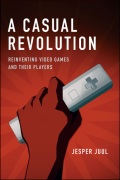
Released in November 2009, A Casual Revolution discusses what is happening with video games right now:
- Why is the Nintendo Wii more successful than the Xbox 360 and the PlayStation 3?
- Why and how is the market for video games expanding?
- Who plays Bejeweled, and why?
- What is a casual player? Do casual players even exist?
- What is casual game design?
- Are casual games a throwback to the arcade game, or are they something new?
- How did Solitaire become one of the most popular video games?
- What is the secret behind the success of Guitar Hero and Rock Band?
- Why is Parcheesi a social game? Why is Animal Crossing?
- Does the rise of casual games mean the downfall of the hardcore game?
![]()
The enormous popularity of the Nintendo Wii, Guitar Hero, and smaller games like Bejeweled or Zuma has turned the stereotype of the obsessed young male gamer on its head. Players of these casual games are not required to possess an intimate knowledge of video game history or to devote weeks or months to play. At the same time, many players of casual games show a dedication and skill that is anything but casual. In A Casual Revolution, Jesper Juul describes this as a reinvention of video games, and of our image of video game players, and explores what this tells us about the players, the games, and their interaction.
With this reinvention of video games, the game industry reconnects with a general audience. Many of today’s casual game players once enjoyed Pac-Man, Tetris, and other early games, only to drop out when video games became more time consuming and complex. For a long time, video games asked players to structure their lives to fit the demands of a game; with casual games, it is the game that is designed to fit into the lives of players. These flexible games make it possible for everyone to be a video game player.
Juul shows that it is only by understanding what a game requires of players, what players bring to a game, how the game industry works, and how video games have developed historically that we can understand what makes video games fun and why we choose to play (or not to play) them.
![]()
- Introduction: A Casual Revolution
 Sample chapter PDF.
Sample chapter PDF.
Spending the winter of 2006-2007 in New York City, I was hearing the same story about how parents, grandparents, partners, suddenly had found an interest in video games through the Nintendo Wii. What was going on? - What is Casual?
What is casual game design? What is a casual player? I argue that casual game design is about flexibility: about letting players decide how and when they want to play a game. - All the Games You Played Before
The story of how Solitaire became the most popular digital game; how we use the games we played before to understand a new game. - Innovations and Clones
A history of matching tile games such as Bejeweled. - Return to Player Space
The success of the Wii, Guitar Hero, and Rock Band explained as a shift of focus from what is inside the screen to the players that are in front of the screen. - Social Meaning and Social Goals
Why Parcheesi/Ludo and Animal Crossing are social games. - Casual Play in a Hardcore Game
How some titles, such as Grand Theft Auto allow many different types of play. - Players, Developers and the Future of Video Games
Are developers obliged to make video games for audiences other than themselves?
Is the future of video games all casual?
- Interviews with casual game players
Four types of player stories:
-The player that returns to video games after a pause.
- The "lapsed hardcore" player that has less free time due to job and family, and therefore starts playing casual games.
- The player that only discovers casual games, and video games, now.
- The player that retires or whose children move away from home and therefore has more time for playing games. - Interviews with game developers
Interviews about the state of casual game design and the future of video games: David Amor, Sean Baptiste, Daniel Bernstein, Jacques Exertier, Nick Fortugno, Frank Lantz, Garrett Link, Dave Rohrl, Warren Spector, Margaret Wallace, and Eric Zimmerman. - Index
 Sample chapter PDF.
Sample chapter PDF.
